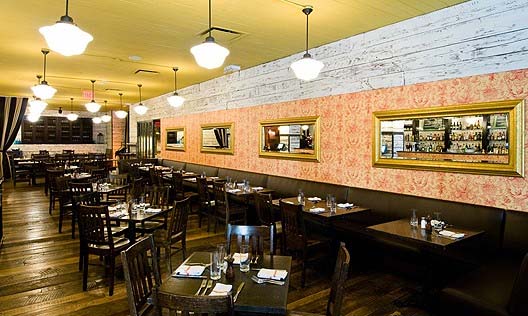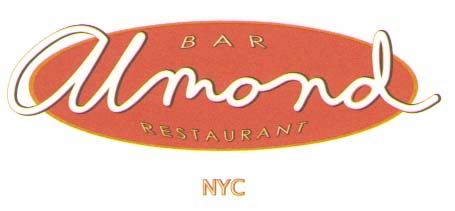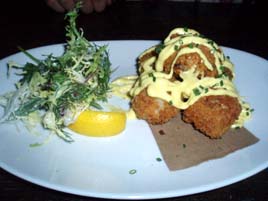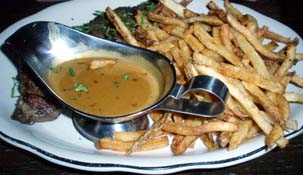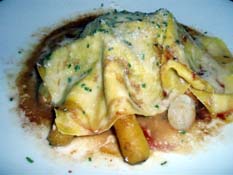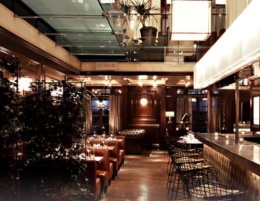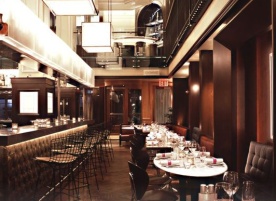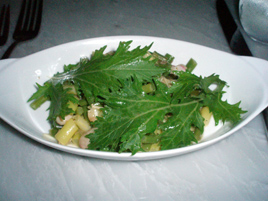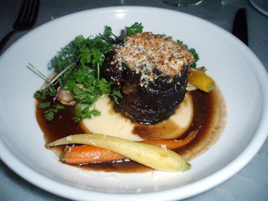Bar Stuzzichini
 Monday, May 11, 2009 at 04:10PM
Monday, May 11, 2009 at 04:10PM 

Note: Bar Stuzzichini, later renamed “Stuzzi,” closed in September 2012.
*
I’ve been catching up on intriguing restaurants that have been open a while, that we missed during the opening review period. For all but the most compelling places, the New York media pays attention—if at all—for only the first few months. The critics then move onto the latest New Thing, and the vast majority of places will never be reviewed professionally again.
Bar Stuzzichini is like that. In September 2007, Frank Bruni’s awarded one star, pronouncing it a “modestly, intermittently troubled” restaurant, but “an honorable effort worthy of note. Its dishes include more successes than failures.”
 At age two, Bar Stuzzichini is surviving, if not quite thriving. At 6:30 p.m. on a Friday evening, we found the outdoor seating packed and most of the bar stools taken, but the large dining room only about 20% occupied. The food was all satisfying and worth a try if you’re in the area, but otherwise not particularly memorable.
At age two, Bar Stuzzichini is surviving, if not quite thriving. At 6:30 p.m. on a Friday evening, we found the outdoor seating packed and most of the bar stools taken, but the large dining room only about 20% occupied. The food was all satisfying and worth a try if you’re in the area, but otherwise not particularly memorable.
The name refers to a broad selection of small plates that dominate the top half of the menu. (Bruni tells us that the Italian verb stuzzicare can mean “to provke,” “to stimulate,” or “to tantalize.”) There are about two dozen of these. They’re $4–10 à la carte, but most people seem to order platters of them. Any three are $18, a portion that is suitable for two to share.
If you order a cocktail during happy hour, you get one of the stuzzichini for free; I tried the Baccalà Fritto or Fried Salt Cod (below left; normally $6), which was nicely done: the fish had a salty brine, the breading was light and crisp.
After we sat down, we had the Salumi Tasting ($28; below right), an ample portion for two. All four meats were excellent (Pork Shoulder, Sweet & Spicy salami, and 18-month prosciutto). My girlfriend was especially fond of the pork shoulder, while I preferred the spicy salami.


On the rest of the menu, salads are $8–9, pastas and soups $7–18, entrées $17–24, and side dishes $6–7.
Neither of our main courses was as memorable as the salumi. Braciole del Pizzaiola, or braised short rib in tomato sauce ($22; below left), had a hearty flavor, but I wouldn’t rush across town for it. Eggplant Parmigiana ($17; below right) was left in the broiler too long, and was a bit burnt.


The wine list is priced in line with the food, with plenty of bottles below $50 (though you can spend more if you want to). We were so delighted with a 2004 Montepulciano d’Abruzzo Riserva ($42; photo above) that we went home and ordered three more bottles of it online.
Service was efficient enough for this type of restaurant. It did not seem to be at all “distracted or perfunctory,” as Frank Bruni reported. We also liked the room and couldn’t at all fathom Bruni’s comparison to a “Midtown mess hall.” Actually, for a large space it is reasonably charming.
If you’re in the area, Bar Stuzzichini offers a refreshing and inexpensive diversion.
Bar Stuzzichini (928 Broadway between 21st & 21nd Streets, Flatiron District)
Food: *
Service: *
Ambiance: *
Overall: *







